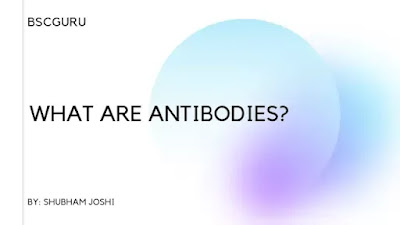Antibodies
At any point asked why your neck district gets enlarged when you are down with a cold and influenza. This is because WBCs gather around that district, which is our bodies' safeguard component in the blood.
Antibodies are not found at a spot thusly, yet at whatever
point our insusceptible framework experiences antigen or a microorganism, B
cells get enacted quickly delivering antibodies into the circulation system.
These immunoglobulins go through mitosis bringing about cell division and
ceaselessly producing antibodies because of delivering more cells. These
antibodies stay in the blood for quite a while yet B cells recollect these
antigens and rehash a similar game-plan at whatever point they return to our
body.
Also read: DNA Fingerprinting
What are Antibodies?
Counter-acting agent (Ab) is otherwise called immunoglobulin(Ig). These are huge, Y-formed blood proteins created by plasma
cells. They tie to unfamiliar particles and attack them. These particles are
unfamiliar bodies that get gone after by antibodies.
Antigens are unfamiliar microbes that attack the body and
have the capacity to lead to a reaction from our resistance framework either by
gathering up with a more extensive particle or alone in the wake of restricting with
antibodies for a specific safe response. Consequently, antigens animate the
creation of antibodies by the resistant framework.
Immunizer Structure
A neutralizer has a Y-formed structure, comprised of four
polypeptide subunits. Every subunit has two indistinguishable light and weighty
chains.
The N-end of every weighty chain frames an
antigen-restricting space with a light chain. Two antigen-restricting spaces are framing the arms of the "Y" shape. They are known as 'section
antigen-restricting' (Fab) spaces.
The C-end of the weighty chains structures the' part
crystallization' (Fc) area, which assists in the association with the effector
cells.
Each of the four polypeptide subunits is kept intact by
disulfide and non-covalent bonds.
The weighty chains of the antibodies contain a variable locale
and three consistent districts. Every immunizer has two indistinguishable
antigen-restricting locales and they contrast in the antibodies.
Sorts Of Antibodies
Antibodies or immunoglobulins(Ig) are of five unique
isotypes. This grouping is based on their H chains. The various kinds of
antibodies are:
IgM
IgM is the primary immunizer delivered in light of a
microbial assault by B cells.
It is the biggest immunizer and is found in a pentameric
structure.
It courses in the blood and lymph and comprises 6% of the
absolute counteracting agent content in the serum.
It is engaged with agglutination and opsonization.
It has countless antigenic locales on its surface and
accordingly works with proficient initiation of the insusceptible framework.
IgG
The most plentiful isotype in the plasma contains 80% of
the absolute immune response content in the serum. It detoxifies substances
that are unsafe and perceives the immunizer antigen complex.
It is moved to the placenta through the embryo and
safeguards the baby until its introduction to the world.
IgG is partitioned into four subclasses-IgG1, IgG2, IgG3,
and IgG4. Among these, the main IgG3 and IgG4 can cross the
placenta.
The weighty chains of IgG have two antigen-restricting
locales and are of the sub-class gamma.
It works with the course of phagocytosis and gives
insusceptibility to the creating baby. It kills the poisons and microbes and
offers insurance to the body.
IgA
Typically found in fluids, for example, bosom milk, serum,
spit, and liquids of the digestive system. IgA in bosom milk shields a baby's
gastrointestinal parcel from microbial movement.
It comprises 13% of the absolute counteracting agent
content in the serum and is partitioned into 2 subclasses-IgA1 and IgA2. Among
these, IgA1 is profoundly tracked down in the discharges and is likewise called
the secretory immunoglobulin.
It exists in both monomeric as well as dimeric structures.
It gives the primary line of protection against the
microorganisms and cutoff points aggravation. It likewise enacts the supplement
pathway and partakes in the resistant reaction.
IgD
It is associated with the development of the neutralizer by
B cells.
It is available as a monomer and weighs around 1,80,000
dalton.
It contains under 1% of the complete counteracting agent
content in serum.
It goes about as a receptor on the B cell surface and takes part
in B cell enactment and separation.
IgE
IgE is available at all sums, around 0.02% of the counteracting agent content in the serum.
These are available in the linings of the respiratory and
digestive systems and answer unfavorably susceptible responses.
This is found as a monomer in the body and weighs around 200,000
Dalton.
Elements of Antibody
Following are a portion of the critical elements of
immunizer:
• Ties to
microbes
• Enacts
the resistant framework in the event of bacterial microbes
• Straightforwardly
goes after viral microbes
• Aids
phagocytosis
• Counter-acting agent gives long-haul insurance against microbes since it endures for a
really long time after the presence of the antigen.
• It kills
the bacterial poisons and ties the antigen to improve its productivity.
• They
additionally go about as the primary line of the guard for mucosal surfaces.
• They
ingest cells by phagocytosis.
• Hardly
any antibodies tie the antigen present on the microbes. These total the
microbe and they stay in emissions. At the point when the discharge is removed, the antigen is likewise ousted.
Also read: Standard Deviation
Creation And Mechanism Of Antibody
Whenever a creature's invulnerable framework experiences an unfamiliar molecule interestingly, macrophages meddle and catch to separate them to pass them to B cells. When these antigens are introduced, B cells start the creation of another immune response which would contain a remarkable paratope (site at which immunizer ties with antigen) to tie with a particular epitope (site in the antigen that predicaments with neutralizer).
Every
lymphocyte of B cells produces a one-of-a-kind immune response against a novel
epitope. When the encoding is finished by B cells, it discharges antibodies
which then tie with explicit microbes bringing about their end from our bodies.
